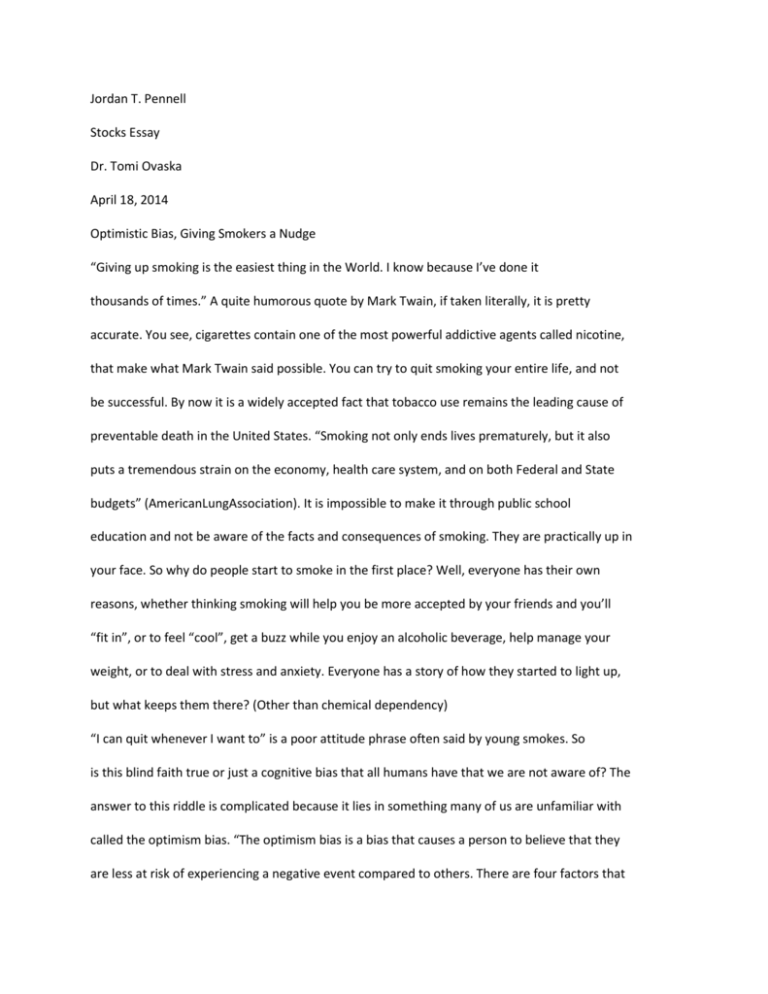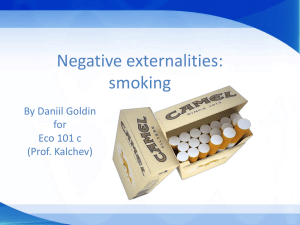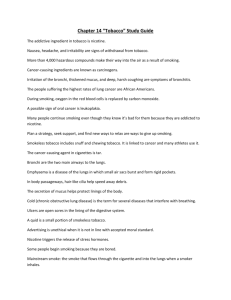Optimistic Bias, Giving Smokers a Nudge
advertisement

Jordan T. Pennell Stocks Essay Dr. Tomi Ovaska April 18, 2014 Optimistic Bias, Giving Smokers a Nudge “Giving up smoking is the easiest thing in the World. I know because I’ve done it thousands of times.” A quite humorous quote by Mark Twain, if taken literally, it is pretty accurate. You see, cigarettes contain one of the most powerful addictive agents called nicotine, that make what Mark Twain said possible. You can try to quit smoking your entire life, and not be successful. By now it is a widely accepted fact that tobacco use remains the leading cause of preventable death in the United States. “Smoking not only ends lives prematurely, but it also puts a tremendous strain on the economy, health care system, and on both Federal and State budgets” (AmericanLungAssociation). It is impossible to make it through public school education and not be aware of the facts and consequences of smoking. They are practically up in your face. So why do people start to smoke in the first place? Well, everyone has their own reasons, whether thinking smoking will help you be more accepted by your friends and you’ll “fit in”, or to feel “cool”, get a buzz while you enjoy an alcoholic beverage, help manage your weight, or to deal with stress and anxiety. Everyone has a story of how they started to light up, but what keeps them there? (Other than chemical dependency) “I can quit whenever I want to” is a poor attitude phrase often said by young smokes. So is this blind faith true or just a cognitive bias that all humans have that we are not aware of? The answer to this riddle is complicated because it lies in something many of us are unfamiliar with called the optimism bias. “The optimism bias is a bias that causes a person to believe that they are less at risk of experiencing a negative event compared to others. There are four factors that cause a person to be optimistically biased: their desired end state, their cognitive mechanisms, the information they have about themselves versus others, and overall mood” (Sheppard). The optimistic bias, sometimes called overconfidence, could be an example in a number of various scenarios, but in this case, smokers have a tendency to believe that they are less likely to contract lung cancer or any other disease or complications associated with smoking than other individual smokers. Daniel Kahenman explains in his book “Thinking Fast and Slow” that human beings like to believe we are rational creatures who are constantly in control, but overconfidence can lead to destructive miscalculations that can be very costly and a potential health hazard. Because of our flaws, humans could use a nudge to help us make better decisions. In a perfect world this could be possible, but the wealthy, influential tobacco lobby preys on our ignorance and flaws, would never allow this to happen. The tobacco industry is a multi-billion dollar operation, but its sheer wealth is unrivaled by the costs of lost productivity, and medical costs as a result of their very existence. To put this cognitive bias to the test, I conducted a voluntary experimental questionnaire on friends, family, and colleagues, all young adult smokers. The goal of the questionnaire was to investigate their personal bias on smoking by measuring how they view their personal risk of smoking compared to others. It is important to remember that overconfident individuals are unwilling to accept the slightest possibility of harm on them. This can be gauged by the severity and likelihood of the outcome. So with all that being said, the results of this experiment are quite predictable. I inquired on a series of two simple questions: (1) what’s the likelihood of you contracting cancer or any other disease or complication related to smoking? (2) What are your chances of quitting, and are you worried about addiction? The answers to this questionnaire were overwhelming similar, despite asking ten different individuals. Question one, seven out of ten responded by saying they do not believe at the moment that they are in any real danger. The common theme or excuse is that they are young and healthy in every other aspect of life. A representative bias, that only unhealthy old people develop health issues. Another alarming response was that they will worry about this (smoking) later in life, that they have more current important issues that need to be resolved first. Two answered somewhat concerned, citing family health issues run in the family, such as high blood pressure and heart disease. Valid reasons to be concerned. The last individual said they were concerned about their long term health, but admitted she was a nervous person in general. The next questions answer go against all reasoning and science, that is quite frightening. Overwhelming, all ten candidates answered by saying they do not see their habit as an addiction or developing into one. They agreed with the phrase “I can quit whenever I feel like it” I was getting the “it’s my life” type of attitude from most of the responders. Maybe they were coming to terms with an unpleasant reality, that they are vulnerable to the consequences of smoking just like everyone else is. There are no good reasons to start a habit, an expensive habit if that; especially when you believe there will be no consequences. A study called “Optimistic bias in adolescents and adult smokers and nonsmokers.” Published in the 2000 edition of Addictive Behavior confirms the findings in my small sample experiment. Jeffery Arnett found “younger smokers displayed some particularly disturbing optimism regarding addiction. The percentage of young adults who agree with the statement ‘I could smoke for a few years and then quit if I wanted to’ was sixty percent compared to twenty six percent of non-smokers. Arnett found in nearly every case, young smokers down play the risks more than adult smokers and both downplayed health risks compared to non-smokers across the board” (Arnett). Reckless behavior by smokers takes a significant toll on the greater economy, as well as personal budgets of smokers. “The Awl” an online news source conducts a survey, yearly, in every state to publish what the average price of a price of a pack of Marlboro Red Cigarettes cost. “The cheapest being Kentucky, at $4.96 and the most expensive, New York at $14.50. Ohio is found in the middle of the pack at $5.88” (SarahJampel). If an individual smokes one pack of cigarettes a day, for one year, in Ohio, that individual literally burns $2,146.20 ($5.88 X 365). Before Sin Taxes. That is no chump change that is a down payment on a brand new car, or to put in every terms: 601 McDonalds Big Macs ($2,146.20/$3.57) Everyone can use an extra $2,000 dollars. The money used to enable an individual’s habit is substituted at the expense of the local economy, instead of patronizing local bars, restaurants, and stores. On a more macro level, “the more recent numbers by the CDC show annual smoking-attributable economic costs in the U.S. are estimated to be between $289 to $332.5 billion dollars. This includes: • $132.5 to $175.9 billion dollars for direct medical care of adults • $151 billion dollars for lost productivity due to premature death • $5.6 billion dollars in lost productivity due to exposure of secondhand smoke” (CDC). Businesses are the biggest losers, set to default millions not only due to workers health-related issues causing them to miss more work more frequently, but also covering employees health insurance. So how can the government nudge smokers to make better decisions? One way the government can help those who are unsuccessful at quitting is by making more alternatives more readily available and affordable. The FDA already approves of medications, such as Bupropion, Varenicline essentially they are like nicotine gum, patches, and lodges that treat the chemical addition to nicotine. With your bodies nicotine thirst under control, you will not have to smoke cigarettes to satisfy your body’s dependence. The problem here is these medications are already available but they are expensive. The government can step in and subsidize these medications. That way they are more affordable to those who would want to take advantage of this opportunity. The U.S. healthcare system is so complicated, that most insurance plans do not cover tobacco cessation treatment. By subsidizing medication, would surely guarantee affordable alternatives that could nudge people to try and kick the habit. The government can also broaden and expand initiatives that are already successful such as smoke free laws. Many state and local governments have already prohibited smoking in indoor public spaces such as bars and restaurants. A 2006 report on the ‘health consequences of involuntary exposure to tobacco smoke’ conducted by the Surgeon General concluded “workplace smoking restrictions lead to less smoking among covered workers, an association between workplace smoking policies, decreases in the number of cigarettes smoked per day, increases in attempts to stop smoking and increases in smoking cessation rates. The report explains in detail that more restrictive policies reduce the number of cigarettes that continuing smokers consume, which prompts more smokers to try to quit, which increases the number of successful attempts” (HHS). By state and local government implementing more restrictive policies public places reduces the amount of cigarettes smokers’ smoke which increases the amount of money in their pockets. A way the private sector can offer a nudge is by providing incentives encouraging employees to quit smoking. The employer can launch almost like an escrow account for employees who choose to stop smoking as motivation, giving them that extra encouragement. How this will work is the employee will deposit how much money they would have normally spent on cigarettes daily into the account. While the employee is depositing the cash in the account, the employee has to agree to quit smoking, and comply with a drug test policy to ensure their good faith. If the employee is successful, the employer will match the balance in the account. So not only will you have saved money from quitting smoking, you will also be paid to do so. The funds in the account will not be tapped until the end of the year. This almost makes this a yearly bonus. This program benefits both the employer and employee. The employer will be saving money in lost productivity and insurance premiums and coverage. A couple bucks a day, is way better than thousands of dollars in avoidable medical bills. The employee will obviously save money by not purchasing tobacco and will be receiving a yearly monetary reward. The policies that I have offered can be expected to be met by heavy opposition in the political arena as well as the private market. The tobacco industry is a multi-billion dollar enterprise whose influential lobby can disrupt any hopes of progressive legislation. The argument against subsidizing tobacco related medication is the taxpayer is funding medication that allows a chemical dependency to fester. Nicotine medication helps regulate and control the body’s dependency but it does not treat and cure the addiction. A tough sell for unpredictable results. As far as prohibiting locations where smokers can legally smoke would be met by libertarian activists who would claim the government is interfering with citizens’ liberty to have a personal lifestyle. “While others would argue over property rights, there is a distinction between private property and nominally public places. Basic institutions of private property rights and contractual freedom are capable of resolving conflicts between preferences of smokers and non-smokers without government intervention” (Valentin). Opponents to employer incentive programs would say such policies would encourage workers to take up the habit in order to receive a monetary reward for quitting. After all if you’re not a smoker, how do you benefit? Despite the anticipated known opposition to any meaningful change, doesn’t mean private and public institutions still can’t try. The current status quo of anti-smoking advertising campaign is essentially ineffective in every aspect. The cognitive bias that is the optimism bias will not make the connection between personal danger and smoking. No matter how graphic the advertising is, it will not work if individuals already have a predetermined judgment that they are somehow the exception. Human beings like to think they are in control of their own fate. They reject the notion they will receive harm for their actions before others. Exactly what the optimistic bias concludes. Young adults will associate one graphic advertisement with old adults, who are already in poor health. You simply cannot “nip it in the bud” with this approach. The unresponsiveness of the government to this situation is a disservice to America. 2088 Words in the body Works Cited Arnett, Jeffrey. "Optimistic Bias in Adolescent and Adult Smokers and Non Smokers." Addictive Behaviors 25.4 (2000) 625-632. Print. HHS. "The Health Consequences of Involuntary Exposure to Tobacco Smoke: A Report of the Surgeon General, Atlanta, GA." U.S. Department of Health & Human Services (HHS) 1 (2006) National Center for Chronic Disease. Web. 13 Mar. 2014. Jampel, Sarah. "What A Pack Of Cigarettes Costs Now, State By State." The Awl. 12 July 2013. Web. 10 Mar. 2014. http://www.theawl.com/2013/07/what-a-pack-of-cigarettes-costs-now-stateby-state Koh (CDC), Howard. "The Health Consequences of Smoking - 50 Years of Progress." A Report of the Surgeon General 1 (2014) 1-36. Print. Petkantchin, Valentin. "Should cigarettes be banned in public places." Montreal Economic Institute 23.1 (2005) Should cigarettes be banned in public places. Web. 13 Mar. 2014. Sheppard, James. "Exploring the Causes of Comparative Optimism." University Of Florida 42 (2002) 65-98. Print. "Tobacco Cessation Coverage 2012." American Lung Association. Helping Smokers Quit, 3 Dec. 2012. Web. 12 Mar. 2014. http://www.lung.org/assets/documents/publications/smokingcessation/helping-smokers-quit-2012.pdf.








